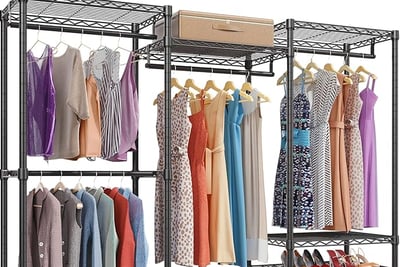DIY Closet Organization: Build Custom Shelves and Storage
8 min read


Introduction to DIY Closet Organization
Effective closet organization is essential for maximizing space, ensuring ease of access, and maintaining a tidy environment. Disorganized closets can lead to frustration as items become lost amidst the clutter. Common issues in chaotic closets include difficulty finding items, wasted space, and an overall lack of efficiency in daily routines. By addressing these challenges through thoughtful design and planning, individuals can significantly enhance their closet experience.
One effective solution to these problems is the implementation of custom shelves and storage options. Tailoring your storage solutions to fit personal needs allows for greater functionality, especially in closets where standard shelving may not suffice. Custom shelves can be designed to accommodate specific items, such as shoes, bags, or seasonal clothing, providing a designated place for everything. This not only increases accessibility but also promotes an aesthetically pleasing environment, making it easier to maintain organization over time.
Engaging in DIY closet organization projects also grants individuals the opportunity to exercise creativity and take ownership of their space. By utilizing various materials and construction techniques, one can craft unique storage solutions that reflect personal style while meeting practical requirements. Moreover, embarking on such projects can be a gratifying endeavor, fostering a sense of accomplishment as one transforms a chaotic space into a well-ordered sanctuary.
Overall, the importance of closet organization cannot be overstated. By exploring custom shelving options and engaging in DIY undertakings, individuals can overcome common organizational challenges. As we delve deeper into the specifics of creating these solutions, readers will find inspiration and practical advice to successfully execute their own closet organization projects.
Planning Your Closet Space
Efficient closet organization starts with a thorough assessment of your current space. The first step in this process is to measure the dimensions of your closet. This includes the height, width, and depth, which will provide a clear understanding of the available area for storage. Additionally, considering clearance space for doors and any obstructions will ensure a more functional layout.
Once measurements are taken, it is crucial to evaluate the types of items you plan to store. Categorizing your belongings—such as clothing, shoes, accessories, and seasonal items—will help in determining what features to incorporate in your custom shelving and storage solution. For example, if you have an extensive shoe collection, you may prioritize dedicated shoe shelves over additional hanging space.
Visualization plays a significant role in planning your ideal closet layout. Utilizing online design tools or simply sketching your closet can help you experiment with various configurations. Consider how often you access different items; this prioritization can inform your layout decisions, placing frequently used items at eye level and less-used items higher up or towards the back.
Moreover, decide on essential features such as shelves, drawers, and hanging areas. Shelves can be adjustable and tailored to accommodate varying heights of items, while drawers are beneficial for storing smaller accessories and maximizing space. Incorporating a mix of these elements can create a highly personalized solution that effectively fulfills your storage needs.
By carefully planning and visualizing your closet organization, you can develop a tailored plan that maximizes the functionality and efficiency of your closet space, making your daily routines easier and more enjoyable.
Materials and Tools Needed for Custom Shelves
Embarking on a DIY closet organization project involves meticulous planning, especially regarding the materials and tools needed to construct custom shelves. The choices you make here can greatly influence not only the functionality of the shelving system but also its aesthetic appeal. Key materials typically include various types of wood, which serve as the foundation for your shelves. Common options are plywood and Medium Density Fiberboard (MDF), both of which offer durability and a smooth finish suitable for painting or staining.
Plywood is a favored choice due to its strength and versatility, particularly for heavier loads. Conversely, MDF is easier to work with and provides a clean surface for finishing, making it ideal for those who prefer a polished look. When selecting wood, consider the weight of items you intend to store; thus, a careful evaluation of the shelf thickness is necessary to ensure proper support.
In addition to the primary materials, you will require brackets, screws, and finishing options. Brackets are essential for supporting your shelves, and opting for metal brackets can provide additional strength and longevity. A variety of screw sizes will also be necessary, depending on the thickness of the wood and brackets chosen. When it comes to finishes, explore paints, stains, or sealants that can enhance the appearance while offering protection against wear and tear.
Equipping yourself with the right tools is equally important. Essential tools for constructing custom shelves include a saw for accurate cuts, a drill for creating holes for screws, a level to ensure that your shelves are straight, and a measuring tape for precise dimensions. Lastly, safety equipment such as goggles, gloves, and a dust mask will protect you during the project, promoting a safe working environment. With the correct materials and tools at hand, you will be well-prepared to tackle your DIY closet organization project effectively.
Step-by-Step Guide to Building Custom Shelves
Creating custom shelves for your closet can greatly enhance your organization capabilities, providing tailored solutions that efficiently utilize available space. To begin, gather all necessary materials and tools, including wooden boards, shelf brackets, screws, a drill, a level, a measuring tape, and sandpaper. The preparation stage is crucial; determine the ideal height and width for your shelves based on the items you wish to store. Be sure to measure the closet thoroughly, as inaccuracies at this stage can lead to difficulties in assembly.
Once you have your dimensions, proceed to cut the wooden boards accordingly. It is advisable to sand the edges for a smooth finish. A clean edge not only enhances aesthetics but also ensures safer handling. After preparing the shelves, designate a workspace to assemble your components. Lay out the wooden boards horizontally and attach shelf brackets according to your measurements. Use screws for a secure fit, ensuring that the brackets can adequately support the weight of the items intended for storage.
Next, securing the shelves to the wall is vital for stability. Begin by marking the desired height with a pencil on the wall. Use the level to ensure that your shelves will be perfectly horizontal; this prevents items from sliding off. Drill guide holes into the wall at the marked points, taking care to locate wall studs for optimal support. After placing the shelving units onto the brackets, firmly secure them with screws. Confirm that everything is aligned correctly before proceeding to the next shelf.
Finally, double-check the stability of your new shelves. Gently apply pressure to ensure they can withstand the weight of your stored items. Once secured, you can paint or stain the wood if you desire a more polished look. This DIY project not only enhances closet organization but also allows you to express your personal style, making it a rewarding endeavor for any homeowner.
Creative Storage Solutions and Ideas
Maximizing closet space is essential for maintaining an organized and functional area. By integrating creative storage solutions, you can transform your custom shelves into an efficient storage haven. One effective approach is to utilize bins and baskets, which can be placed on shelves to compartmentalize various items easily. Clear plastic bins allow you to see the contents at a glance, while fabric or woven baskets add a touch of style to your closet. Ensure that you choose the right sizes to fit your shelves and the items you wish to store.
Labeling is another powerful tool for enhancing organization. By labeling bins or baskets, you create a streamlined way to identify contents quickly, reducing the time spent searching for specific items. Utilize a label maker or simply write labels by hand for a personal touch. This small effort can significantly improve the functionality of your closet, helping you maintain order consistently.
In addition to bins and labels, incorporating hooks or hangers can elevate your storage strategy. These can be installed on the inside of the closet door or on the wall to hold accessories, bags, and hats, thereby freeing up shelf space for other items. Consider adjustable hooks that allow you to change the height based on your needs. Vertical space can often be overlooked, yet it is an essential component of effective closet organization. By incorporating tiered shelves or hanging racks, you can creatively increase your storage capacity.
Lastly, think outside the conventional closet organization ideas. For instance, an over-the-door shoe organizer can serve not only for shoes but can also be repurposed for storing small items such as scarves, ties, or even cleaning supplies. Merging function with creativity transforms your closet into a visually appealing and organized environment. Exploring these creative storage solutions will inspire you to create a closet that meets your needs while maintaining an orderly aesthetic.
Maintaining Your Organized Closet
Once you've invested time and effort into organizing your closet with custom shelves and storage solutions, the challenge lies in maintaining that order. Regular decluttering is essential to keep your closet looking its best and functioning efficiently. This involves periodically assessing your belongings and determining what you truly need versus what can be donated or discarded. A good rule of thumb is to revisit your closet every season; this allows you to evaluate items that may no longer fit your lifestyle or needs, facilitating a streamlined closet environment.
Another strategy is to organize seasonal items effectively. As seasons change, so do your clothing and accessory needs. At the start of each season, swap out seasonal items, placing off-season clothing in storage boxes or high shelves. By doing this, you not only free up space but also make it easier to access items that are relevant for the current climate. Labels on storage boxes can significantly enhance organization and accessibility, allowing you to quickly find what you need without unnecessary rummaging.
Accessibility should remain a key consideration in your closet organization strategy. Ensure that frequently used items are within easy reach, while less-used items can be stored higher or in the back. Making adjustments when necessary, such as reorganizing shelves or adding additional storage, will help to maintain a functional closet that meets your evolving needs. Setting a routine for upkeep—say, dedicating 10-15 minutes each week to tidy and organize—will help prevent clutter from accumulating over time. It’s about creating a sustainable system that evolves with your lifestyle changes, ensuring your organized closet remains a source of satisfaction and efficiency.
Conclusion and Final Thoughts
In summary, DIY closet organization offers a multitude of benefits that can significantly enhance both the functionality and aesthetic of your living space. By undertaking the project of building custom shelves and storage solutions, you are not only able to tailor your closet to meet your unique needs, but you also gain an opportunity to express your personal style. A well-organized closet can transform the way you interact with your clothing and accessories, making it easier to find what you need while reducing daily stress.
Building your own shelves allows for a level of customization that pre-made solutions often lack. Whether you require extra space for shoes, a designated area for seasonal items, or simply a more organized approach to your daily wear, the possibilities are endless. This hands-on approach fosters a sense of ownership over your space and encourages thoughtful planning and execution of your design vision. Additionally, the act of completing a DIY project can yield a satisfying sense of accomplishment that inspires further creative endeavors.
We encourage you to take the plunge into your own DIY projects, as the potential rewards far outweigh any initial hesitations. Embrace your creativity, and allow your imagination to guide you in transforming your closet space into an inviting and functional area. As you embark on this journey, we invite you to share your experiences, challenges, and tips with others who may be considering similar projects. Your insights can be invaluable in inspiring and assisting fellow DIY enthusiasts in their quest for an organized and aesthetically pleasing closet.











